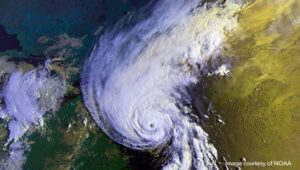Monster Hurricanes Reached U.S. During Prehistoric Periods of Ocean Warming

Research on coastal sediments, funded in part by BIOS’s Risk Prediction Initiative, shows that prehistoric hurricanes along the northern East Coast of the United States were likely more frequent and intense than those that have hit within recorded history. The hurricanes that battered New England in the first millennium were produced in part by warmer sea surface temperatures in the Atlantic Ocean. By looking to the past, these data can help scientists better predict the frequency and intensity of future hurricanes as the ocean continues to warm due to climate change.
“BIOS, through the Risk Prediction Initiative and other efforts, has long supported the field which has come to be known as paleotempestology, the study of prehistoric storms,” said Dr. Mark Guishard, Program Manager of RPI. “Through sediment cores at coastal sites, and the study of chemical isotopes extracted from tree rings, coral samples and speleothems (cave formations), researchers can obtain information about storms prior to the instrumented and observed historical record, and even quantify their return frequency over millennia.”
